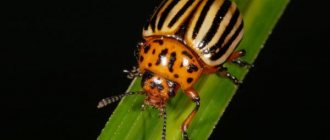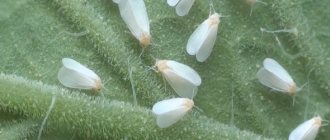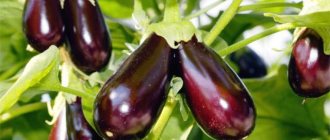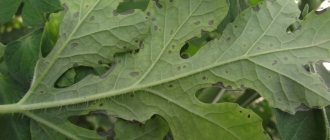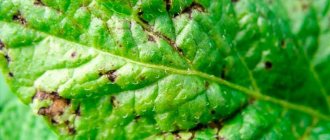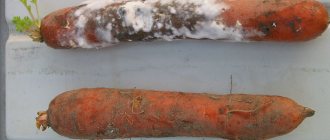Home / Pests and diseases
Back
Published: 06/23/2019
0
4/5 — (2 votes)
Among potato pests, the Colorado potato beetle, which is distinguished by its endurance and gluttony, is usually put in first place. But another enemy is no less dangerous - the potato nematode, which is difficult, and most often impossible, to get rid of. Crop losses can be up to 50-80%, so the main thing is to prevent the appearance of the pest on the site.
- 1 Description of the pest
- 2 Varieties
- 3 Signs of potato damage
- 4 Control methods 4.1 Chemicals
- 4.2 Folk remedies
- 4.3 Agrotechnical methods
Description of the pest
Nematodes are one of the most dangerous potato pests. This is a microscopic roundworm 0.6-1 mm long. It can live on the roots, tubers and stems of the plant. The female's body is round in shape and smaller in size than that of the male. In summer it is white, by autumn it acquires a golden-brown or brown tint.
Photo of potato nematode. Taken from wikimedia.com
The male lives for 1.5 weeks and dies after fertilization of the female. Females accumulate up to 800 eggs in their bodies. In the fall they die and turn into cysts in which eggs are stored. Under favorable conditions, egg capsules can be stored for up to 10 years.
How dangerous is a nematode?
The nematode actively attacks the root system of potatoes, stolons, and tubers. Able to penetrate stems without much difficulty.
- Potato plants begin to lag in growth, produce minimal yield, and die if heavily infested.
- Tubers affected by nematodes usually begin to rot. Such tubers are not eaten as food, and it is useless to store them.
- In addition, even if the nematode has only slightly affected the plant, it often carries a viral infection. And if the physical damage is small, then the viruses carried by the nematode will do their job and still destroy the plant.
| The potato nematode can cause you to lose no less yield, and sometimes even more, than the Colorado potato beetle. Crop losses often exceed 50% and reach 80%. |
The danger for plants is maximum, because sometimes it is not possible to completely defeat the nematode; they are quite resistant to various insecticides. Nematodes parasitize mostly in that part of the plant that is located under the surface of the soil, and this greatly complicates treatment and complicates the detection and identification of the pest.
| IMPORTANT Nematode does not pose a danger to humans |
Types of nematodes
There are several types of pests, the most common in our country is the golden nematode.
Potato golden nematode
This type of nematode damages the roots of the plant, which become too branched.
Nutrients do not circulate well, and as a result, the lower leaves of the bush begin to dry out. The tubers are small or not formed at all.
Stem nematode
The pest attacks potato stems and tubers.
Dark spots appear on the skin of the tubers. The pulp becomes loose or turns into dust.
Root-knot nematode
This type of nematode destroys the roots and tubers of the plant.
Growths or galls up to 3 cm thick form on the roots. Potato tubers become lumpy. The pest also affects pumpkin crops.
Pallid nematode
On plantations affected by the nematode, rare, painful stems are formed.
There are no more than three of them, they turn yellow prematurely. The tubers are formed very small or not formed at all.
Root nematode
This type of nematode affects plants both in open and closed ground. It parasitizes various types of crops, including potatoes. Localized in the root system and tubers. Females lay eggs directly in the roots. Of all types of potato nematodes, they lead in fertility - up to 2000 eggs, as a result of which new growths - galls - are formed in infected areas.
Damage blocks the flow of water and nutritional components into the plant, which in turn leads to retardation in growth and development and, accordingly, affects the yield.
Control measures:
- Maintaining crop rotation and alternating crops resistant to the pest.
- Treating the soil with steam or preparations from the Avermectin group, which are a double complex of biological components and chemical compounds.
- Disinfection of planting material and equipment.
Lack of moisture provokes the development of the population and reproduction of root-knot nematodes, so in dry years their greatest distribution is recorded.
Control of potato nematode
Pest control is complicated by the fact that it is difficult to immediately notice it on potatoes. Gardeners use different means.
Chemicals against nematodes
Chemicals are used when absolutely necessary because they are toxic.
The most commonly used means of contact action are:
- Lindan,
- Karbofos,
- Phosphamide.
It must be remembered that for greater effect, chemicals are combined with biological and agrotechnical means.
Folk remedies
Before planting potatoes, spray the infusion of sprouts from the tubers. This will lure the larvae out of the cyst, and they will die from lack of food.
Along the perimeter of the potato plot, plant plants that repel parasites:
- marigold,
- beans,
- calendula.
Biological products
Biological preparations have a narrowly targeted effect and act directly on the pest. These include: Basamil, Metarizin.
Agrotechnical methods
When planting potatoes, add the following to each hole:
- manure,
- chicken droppings,
- ash.
You can use mineral fertilizers containing:
- nitrogen,
- potassium,
- copper,
- phosphorus,
- cobalt
- and manganese.
Enriching the soil with minerals will prevent the development of nematodes.
How can you tell if a potato has been infected by a nematode?
In fact, detecting a nematode on potatoes in the early stages is quite difficult, because the nematode lives underground.
Often, gardeners understand that potato plants are affected by a nematode due to a number of signs:
- leaf blades began to turn yellow, lose turgor,
- when the plants themselves wither,
- Deformations are often noticeable on potato shoots and flowers.
It is possible to determine the presence of a nematode using these signs, which is a plus. However, the downside to this is that once the plants wilt, it is often impossible to save them.
The earliest signs of the presence of nematodes on potato plants are:
- sharp yellowing of the edges of leaf blades, when there are no other prerequisites for this,
- Further, we can talk about the presence of a nematode on potato plants by even slight deformations and swellings on the stems - this is precisely a sign of a stem nematode ,
- further, if you notice slight wilting of the lower leaf blades and shoots without other reasons, then this also indicates the presence of a nematode,
- and if the potatoes have unnaturally small buds and flowers, then this can also tell us about the presence of a nematode on the plants.
If potato plants are significantly affected by the nematode, they may not bloom at all, and the potato tops usually become terry.
If you dig up such plants, you will find thickenings on their root system - they indicate the presence of a root-knot nematode , but if you see cyst balls, then this indicates the presence of a golden nematode .
If in doubt, I advise you to contact specialists from one of the regulatory authorities, since the nematode is a dangerous quarantine pest. Timely detection and destruction of this pest is the key to further full cultivation of potatoes in this area.
Preventive measures
Potato nematode does not respond well to various drugs; preventive measures are more effective:
- Competent crop rotation. Potatoes cannot be planted in the same area every year. Do this once every 3-4 years.
- Sow mustard, rye, legumes, marigolds, and calendula on the affected area. Excretion from their roots is destructive for the pest, but for the soil it is an excellent means of replenishing lost elements. Useful information: Green manure what is it Mustard as green manure Spring vetch - fertilizer for the garden
- Use urea. In autumn and spring, add the drug to the soil; the nematode does not tolerate this product. Learn how to use urea as fertilizer.
- Use healthy tubers. Before planting in the ground, they need to be treated with potassium permanganate.
- Increase soil fertility. There will be more earthworms, and they are the enemies of the nematode.
- Use nematode-resistant potato varieties. But after 3-4 years they need to be replaced with regular ones, as the pest quickly adapts.
- Burn the tops of diseased plants.
How to get rid of nematodes on potatoes?
It is often not possible to completely defeat a nematode on an area, but it is within your power to significantly reduce the number of this pest and reduce the number of nematodes on an area to a minimum.
Chemical control agents
To effectively combat nematodes, it is appropriate to use insecticides from the group of nematicides .
1. It is quite possible to use drugs from the contact group, such as
- Karbofos,
- Lindan,
- Phosphamide.
2. It is permissible to use fumigants that, in the form of gas, penetrate the pest’s body and kill it; these are drugs:
- Chloropicrin,
- Nemagon,
- Carbation.
Biological products
It is quite acceptable to use biological preparations to combat nematodes, but their effectiveness is not very high and if the soil and plants are heavily infested with nematodes, they can be said to be ineffective.
These are biological products:
- Metarizin,
- Basamil.
Folk remedies
Using various kinds of infusions and decoctions to combat nematodes is not effective, you will simply waste your time and energy, they will not be of any use or will be of very little use. In this case, biological preparations will be much more effective than folk remedies based on decoctions and infusions, and there will be no harm to the environment from biological preparations as well as from infusions and decoctions.
Watering with boiling water
Of the folk control measures, perhaps the most effective would be to use boiling water to scald the soil.
- The hottest boiling water is used for this.
- The soil must be loosened and generously watered with boiling water.
- It is advisable to repeat the procedure several times in order to disinfect the soil as much as possible and to the greatest possible depth.
It is clear that it is appropriate to treat the soil by pouring boiling water over it in small areas. But on large areas, from 10 acres or more, it is more appropriate to use chemicals.
Marigold
There is also an opinion that the smell of marigolds repels the potato nematode; whether this is true or not is difficult to say, but there is nothing easier than sowing marigolds around the perimeter of a plot with potatoes - it’s beautiful, and there is a chance that the nematode will not appear or will leave your plot.
Methods of control and treatment
The fight against potato nematodes involves various agrotechnical and chemical means. On private farms, folk methods of control give good results. The choice of method depends on the degree of soil contamination and the type of farm.
Agrotechnical
These methods are the most accessible and environmentally friendly.
These include:
- application of organic fertilizers;
- weed control;
- alternation of planted crops;
- selection of optimal dates for planting and harvesting potatoes.
Important! In areas of severe damage, it is recommended to destroy crops by digging up and further burning. Equipment and soil must be disinfected.
When growing potatoes for seed, you can use false sowings, when the planted potatoes are destroyed after the larvae have entered its root system and gone through the second stage of development. This method helps protect up to 80% of the seed material from infection.
Chemical
Plant parasitic nematodes are most vulnerable during their active phase in the soil while searching for the roots of host plants. Chemical control methods are most often used on large farms where there is special equipment and trained personnel. These include treating the soil with fumigants, which, when entering the respiratory system of the parasite, lead to its death.
Fumigants should be applied to the soil at a temperature of +12°C to +15°C since dispersion is related to temperature. Chemicals help establish a high level of control. This is especially important when growing potatoes for export.
Important! When processing with fumigants, safety precautions should be observed, since drugs in this group can be harmful to human health.
Folk remedies
People have long known how to deal with this pest. The most accessible folk remedy is to plant marigolds next to potato beds. The substances they secrete have a detrimental effect on the pest and contribute to a significant reduction in the population.
It is possible to almost completely get rid of parasites using boiling water. To do this, pour the area with hot water (not lower than +60°C) to a depth of about 20 cm. This method is used when the lesion is minor or in isolated lesions.
What kind of beast
Nematodes are a type of roundworm. One female can give birth to up to 250 new individuals; 10 generations can change in a year. Nematodes are native to South America. Eggs can survive frosts, floods, radiation, and droughts.
The worms themselves are very small, but can destroy up to 80% of the potato crop. The size of the worm is up to 1.63 mm. The most favorable temperatures for nematode reproduction are 20 to 24 degrees above zero. Potato species are respected not only by people, but also by worms. The most common types of nematodes on potatoes are:
Since it is a polyphage, it affects not only potatoes, but the following plant species:
Potatoes are damaged during the growing season and also live in storage on tubers. It feels most comfortable in damp basements and generally in damp environments. They can be identified by small white spots with a hole in the center. They are found under the skin. The affected area can be found when palpating the tubers - it becomes soft.
Then the tissues become brown, the skin above them cracks, and the flesh crumbles. Worms, larvae, and nematode eggs can be found in diseased tissues. Potatoes rot and wrinkle over time, and are subsequently destroyed by bacteria and fungi.
Golden
The most common type of nematode in Russia. They penetrate the roots and feed on potato juices, preventing beneficial substances from reaching other parts of the potato. The affected plant dries quickly. The process starts from the leaves at the bottom. Tubers are either absent or very small, but the root system is very branched. The female turns into a cyst in the fall, which can contain about 8 thousand eggs. Such a cyst can be viable for up to ten years. Larvae can hatch from it at different times.
It differs from the previous one only in color. Females turn brown over time.
The pest can be identified by its lumpy tubers. Also, bumps can form on the roots. This nematode prevents water and nutrients from reaching the stems.
Preventive methods
To prevent the spread of the pest on the site, there is one main method - alternating crops. In addition, the following prevention methods are used:
- It is necessary to dig up the site in the fall.
- Use organic fertilizers.
- Periodically plant cabbage or flower crops on the site. Asters and marigolds secrete special juices that kill cysts and larvae.
- Buy only fresh and clean seeds from trusted suppliers.
- The affected crop should be burned or used as animal feed.
- Wash potato tubers before planting and disinfect equipment.
If you promptly take care of the cleanliness of the soil and check all the seeds that are planted, you can avoid contamination of the soil and plants with pathogenic microorganisms.
Varieties
20 species of the pest are known and described. The four most common types are:
- Potato golden nematode. It is highly fertile: each cyst contains up to 70 eggs. Moreover, the cysts themselves are very durable and do not collapse even at low temperatures in winter. These formations can be discovered by digging up potato bushes. You can only notice it on close inspection - the balls are microscopic and golden in color.
- Pale potato nematode is similar to the golden one in that it also produces flowers, but they are yellow in color rather than brownish brown. It affects leaf blades, which disrupts photosynthesis. As a result, the leaves begin to wither, which can lead to the death of the entire bush.
- Potato root-knot nematode - a pest that attacks the roots of the plant. The body is white, then becomes almost transparent. Worms lead to the formation of galls - small swellings on the roots. Eggs develop in them, from which larvae subsequently form.
- The potato stem nematode has a body length of about 1.5 mm. The larvae feed on the pulp of stolons and potato tubers, leading to deformation of the stems, which is why the name of the worm is associated. The cyst is viable for five seasons. Its shell does not die even at high temperatures.
Pests are very dangerous, since their appearance leads to significant crop loss, on average about 30%. At the same time, advanced cases are known when about 80% of the tubers died. Another danger of the potato nematode is that it is a carrier of certain viruses. And while it is still possible to deal with worms, it is more difficult to prevent the development of a viral infection.
Attention! There is a widespread misconception about the negative impact of golden and other potato nematodes on humans. In fact, the pest is only dangerous for potatoes during the growing season. It does not threaten people's health.
Signs of potato nematode on the site
Potato worms are a hidden threat. They can only be detected when obvious signs of infection appear on the leaves and stems of plants. This period generally falls 6-7 weeks after planting. Signs of a pest attack are as follows:
- the plant stops growing and developing;
- the lower leaves turn yellow;
- stems curl;
- flowering is either completely absent or very weak;
- bushes do not grow to the required size;
- the roots turn brown.
Curling of the stems is a sign of potato nematode.
Another obvious sign is the appearance of white spots on the tubers and loosening of the tuber structure.
Prevention measures
The nematode is a malicious parasite, the appearance of which on the site is easier to prevent. As a preventive measure, you must follow some rules:
- tubers must be disinfected for planting;
- follow the rules of crop rotation, i.e. do not plant the same vegetables in one place all the time;
- treat holes and tubers before planting;
- apply fertilizers and biological preparations against pests in a timely manner;
- remove plant residues after harvesting.
The best way out of the situation is to choose a potato variety for planting that is resistant to nematode attack.
These are early ripening ones - Liga, Krepysh, Gloria, mid ripening ones - Aurora, Yanka, Cascade and late ripening ones - Volare, Vektar, Zhuravinka. If parasites decide to feast on one of these types of potatoes, they will remain walled up in it. At the first attempts to penetrate someone else's tuber, the potato's tissues harden. Thus, the larvae remain inside the fruit, they lack nutrition and die, unable to develop further.
Potato nematode is a quarantine disease. It is the duty of the owner of a garden where pests were found to report this to the relevant authorities. After this, the entire area is taken under phytocontrol supervision until the worms and their larvae are completely exterminated.
Potato nematode: description, photo and treatment. How to properly fight in the garden
Nematodes are microscopic roundworms of which there are more than 25,000 species. Some nematodes are completely harmless and thrive in soil, sea or fresh water, while others are parasites and infect animals or plants. They live in moist soil or directly inside the plant. If the potato is growing slowly, the lower leaves of the tops have turned yellow and they are drying out, all these signs indicate the presence of nematodes.
In the video, potato nematodes:
Signs of a pest
The first signs of parasite damage appear on days 45–50 of the vegetative period. Infected bushes differ in the following characteristics:
- slow growth of green mass of the bush;
- yellowing of the lower leaves;
- drying of the tops before the harvest time;
- leaf curling;
- uneven stem shape;
- small fruits;
- roots turn brown;
- lack of flowering;
- the appearance of small white or yellow balls on the tubers;
- loose structure of the root crop;
- black spots on tubers.
Related article: Do potatoes need tops - signs and timing of mowing
Potato varieties resistant to nematodes
The table shows varieties with immunity to nematodes. The root system of plants resists parasites, killing about 80% of worms.
| Name | Originator | Ripening time, days | Tuber weight, g | Productivity, c/ha |
| Limonka | Agrico | 110–120 | 75–125 | 193–315 |
| Krinitsa | RUE "Scientific and Practical Center of the National Academy of Sciences of Belarus for Potato Growing and Horticulture" | 110–120 | 88–136 | 171–280 |
| Red Scarlet | HZPC HOLLAND B.V. | 70–80 | 56–102 | 164–270 |
| Atlant | RUE "Scientific and Practical Center of the National Academy of Sciences of Belarus for Potato Growing and Horticulture" | 110–120 | 90–119 | 164–260 |
| Rosara | SAKA PFLANZENZUCHT GBR | 50–65 | 81–115 | 202–260 |
| Stonefly | RUE "Scientific and Practical Center of the National Academy of Sciences of Belarus for Potato Growing and Horticulture" | 110–120 | 93–127 | 235–368 |
| Uladar | RUE "Scientific and Practical Center of the National Academy of Sciences of Belarus for Potato Growing and Horticulture" | 50–65 | 91–140 | 127–261 |
| Lily Belarusian | RUE "Scientific and Practical Center of the National Academy of Sciences of Belarus for Potato Growing and Horticulture" | 65–70 | 102–200 | 246–407 |
| Yanka | RUE "Scientific and Practical Center of the National Academy of Sciences of Belarus for Potato Growing and Horticulture" | 90–100 | 81–106 | 195–360 |
| Zekura | Solana | 80–95 | 59–150 | 195–365 |
| Arizona | Agrico | 70–80 | 112–150 | 255–577 |

